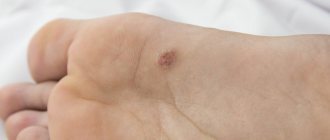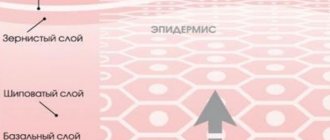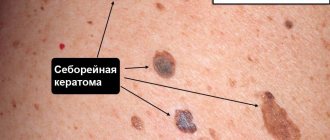What is a callus
A callus is a conical thickening of the skin that occurs in areas of constant friction or pressure. Most often, calluses appear on the feet (heel, big toe, side of the foot) and on the hands. In men, a callus may appear on the penis due to frequent wearing of too tight underwear.
The main symptom of the appearance of callous formations is the formation of tubercles of rough skin. Depending on the location and appearance, there are several types of calluses:
- dry;
- wet;
- bone.
A dry callus is a small area of thickened, dead skin that is yellowish in color. A wet callus has a thinner surface and is often filled with lymphatic fluid. Callus occurs during the process of bone regeneration after fractures. Separately, bloody calluses, core calluses, and calluses are also distinguished.
Core (root) callus is a type of dry callus and is distinguished by the presence of a thickened keratin core. The external manifestation of a root callus is similar to that of a plantar wart, so a dermatologist can make an accurate diagnosis after performing a dermatoscopy.
Calluses (corns) are wide, flat thickenings of the skin that do not have a hard center. Corns on the feet and hands rarely cause pain when pressed.
A callus with blood is a type of wet callus filled not only with lymph, but also with blood. A callus occurs when blood vessels are too close to the surface of the skin that has been subjected to friction.
Removing dry callus
Structure of dry callus
In medicine, excessive thickening of the stratum corneum is called hyperkeratosis.
If the process of keratinization proceeds normally, aging cells in young people exfoliate after 28 days, in those who have crossed the forty-year mark - after 72 days. Together with them, the skin gets rid of mechanical impurities, sweat residues, and related substances.
Places regularly exposed to mechanical irritation are covered with dead cells (corneocytes). Beneath the layers of scales lies the core of the callus. It has the shape of a cone, the tip growing into the deep layers of the skin. If the nucleus is superficial, the dry callus is practically painless and, over time, the corneocytes will fall away from the dermis.
If the cone is dense and powerful, it continues to grow deeper. When the rod reaches the nerve endings, it causes severe pain. If large dry calluses with a core are not isolated, the cause of their spread may be a viral or fungal papilloma infection.
A dry callus without a core appears in appearance as a relatively smooth area of rough skin with circle-shaped borders. It may differ from the color of the surrounding skin by being slightly yellowish in color, and sometimes redness can be seen. The callus is dry, hard, but painless.
The callus is slightly raised above the surface of the skin. like a mushroom cap. This elevation has a yellow or whitish color with a clear papillary pattern of dead dermis. A crust is clearly visible in the center, which can be soaked and removed. Then a rod is visible in the depression - a dense skin formation. Such a callus is painful - both when walking and performing everyday household needs, and when trying to carry out any manipulations to remove it.
Why do dry calluses form?
By the places in which dry calluses form, you can judge with a high degree of probability what a person does.
Calluses on the hands occur:
- when working with a heavy and inconvenient working tool;
- when exercising on sports equipment;
- when playing musical instruments.
Calluses on the feet are typical:
- for people suffering from foot deformities, arthrosis and arthritis;
- for untrained people forced to do hard work that is unusual for them;
- for those who are overweight;
- for people forced to wear tight or poor-quality shoes;
- those who wear shoes carelessly, on socks or tights that form folds.
Calluses are not only a cosmetic defect. Sometimes they are harbingers of serious diseases, such as:
- diabetes. In this case, it will be possible to cure calluses only after normalization of glucose levels;
- atherosclerosis, obliterating endarteritis, thrombophlebitis. These are diseases that disrupt the blood supply and nutrition of the tissues of the foot;
- insufficient amounts of vitamins A and E. The skin dries out, it is difficult for it to resist infections, exfoliate the epidermis and maintain elasticity;
- fungal infections. Before getting rid of dry calluses, it is necessary to cure fungal infections of the feet. Otherwise, dryness, irritation and the appearance of cracks in the skin will cause constant discomfort and slow down the restoration of the epidermis.
Do dry calluses need to be treated?
Dry calluses can and should be treated. Otherwise, trying to avoid pain or discomfort, you will change physiologically correct movements, work incorrectly with sports equipment or instruments, and increase the load on the spine. This is fraught with the occurrence of joint pathologies and can result in arthrosis and arthritis.
If you do not pay attention to core calluses, they form cracks in the dermis, where infectious agents penetrate, as if through an open gate.
Removing dry calluses
The callus can be treated at home if it does not have a core or
is not infected (does not turn red, does not secrete pus or ichor), its appearance is not provoked by a fungal infection or papilloma virus.
Please consult with the following relevant experts in advance:
- Endocrinologist. It is necessary to make sure that the callus is not a harbinger of diabetes;
- Vascular surgeon - will assess the condition of the blood vessels and, if necessary, recommend how to strengthen them;
- Neuropathologist. It is important to know that hyperkeratosis is not a consequence of diseases of the nerve fibers;
- Dermatologist. You need to be sure that dry callus is not a consequence of the action of papillomavirus and fungal infection.
To remove calluses at home, warm your feet in a hot solution with the addition of soda and soap crumbs (for at least 15 minutes) and remove rough skin with a pumice stone or foot scrub. Next, apply the ointment or fatty cream recommended by your doctor.
You can use pharmaceutical preparations based on salicylic acid, patches made on the basis of hydrocolloids, gels using trichloroacetic acid. Modern pharmacology offers home horn cleansing with products based on refrigerants, cauterization with drugs containing phenol, and combined products.
The effect will be achieved with persistent and consistent use of the drugs over a long period of time. Many of them are aggressive and must be strictly dosed; they can burn the skin and cause infection to penetrate weakened areas. And you need to store drugs in a place that prevents accidental access to them by children.
Surgical removal of dry calluses with a rod
Surgeries in a clinic remove a painful defect easily and quickly. If you take precautions, the callus will not grow back in the same place.
Main methods of treatment:
- Laser removal. It is used for viral and fungal skin lesions and in difficult situations when the callus is infected. A narrowly directed beam painlessly removes keratinized scales and stems. In 80% of cases, 1 session is enough. The price of removing dry callus with a laser depends on the level of complexity of the operation. Advantages of the laser method:
- the risk of infection is minimized;
- the callus will not grow back;
- passes bloodlessly and painlessly;
- does not leave scars or burns
- Removal using liquid nitrogen. It is difficult to control the depth of cold penetration, so the method is used in small areas. After applying nitrogen, a wet blister appears that takes time to heal. A repeat session may be needed to achieve the full effect.
- Electrocoagulation. This is a method of thermal removal of callus with a rod. If cauterization is not carried out deeply enough, the callus may form again. Nowadays this method is rarely used.
How does laser removal of dry calluses work?
Before the manipulation begins, the area affected by the laser is anesthetized with an injection, then the laser beam is directed to the callus. Depending on what type of radiation the doctor chose, the callus may evaporate or curl into a clot. The resulting formation is then easy to remove.
A small wound remains at the site of the callus, which is treated with a medicinal solution and protected with a bandage.
The duration of the procedure is from two to five minutes.
After leaving the doctor's office, you can immediately return to your normal lifestyle. But for 2-3 days, until the wound is completely healed, it is better to wear loose, comfortable shoes and not visit the bathhouse or sauna.
The wound should be treated in the same way as a regular household cut, daily, using brilliant green or chlorhexidine, each time applying a fresh, clean bandage.
Causes of calluses
In response to constant friction and pressure, cells begin to synthesize increased amounts of keratin, the skin's protective protein. With calluses, keratin can form a plug in the deep layers of the skin. The main reasons for the formation of calluses on the feet and hands are:
- wearing shoes of the wrong size;
- foot deformities (hammer toes, bunions, bone spurs);
- chafing of the skin due to professional activities (musicians, weightlifters, artisans);
In tight shoes, the skin of the foot is strongly compressed, and in too loose shoes, it slips and rubs, which can cause internal (core) calluses to develop. Calluses on the foot due to toe deformities occur due to improper weight distribution. Due to frequent rubbing of the skin of the hands with professional instruments (strings, bars), calluses appear on the hands.
Anatomical and physiological essence of calluses
To successfully treat calluses, you need to understand why they occur.
The skin is designed in such a way that it is not afraid of external irritants (chemical, mechanical, thermal). And thanks to the regular proliferation of cells, it is able to quickly regenerate (old cells are rejected, new ones appear in their place).
But with prolonged mechanical action, friction, pressure, excessive irritation, the skin becomes rough and calluses appear. Most often they are formed due to permanent friction on the hands and feet. Although calluses are often observed on the elbows, tongue, gums and even in such unusual places as the male penis, labia in women, nipples and areas of skin under the nails.
More information about what atypical places calluses can form and what this means for the patient can be found on the pages of our website https://www.dobrobut.com/. Also on the site you will find other useful information about calluses and corns.
Dry and wet calluses
Dry calluses are keratinized areas of skin that form in places where bone presses on the skin of the feet (tops of the toes). If you frequently wear tight shoes, dry subungual callus may form.
Wet (water) calluses are whitish-gray in color and have a softer texture because they form in areas of increased sweating on the feet and hands. Water calluses often form between the fingers and toes. If a wet callus on the foot is damaged, an infection can enter the wound, so it is important to treat the damaged area of skin with antiseptic agents.
Callus
Callus formation is an important step in the process of bone tissue repair after injury because it helps connect the parts of the damaged bone. After a fracture, the callus is enriched with calcium and gradually turns into normal bone tissue.
Due to insufficient immobilization or poor circulation at the fracture site, callus may form too slowly (delayed fracture consolidation). Its slow formation can cause the bone to heal incorrectly and cause pain.
How to get rid of calluses?
To get rid of calluses, it is enough to temporarily eliminate activities that cause chafing of the skin. You can remove dry calluses manually: you need to steam the skin of your hands and remove rough areas using pumice. In addition, the surgeon may recommend the use of keratolytic agents, which soften the skin. You cannot remove calluses on your own with the help of keratolytics if you have diabetes or pathologies of the immune system, since after removal a wound may form through which an infection can enter the body
You should see a doctor if the callus is painful to step on or touch, as this symptom may indicate the presence of a heel spur, a calcified growth on the surface of the bone. Removal of the callus core is performed by a doctor because removing the callus at home is ineffective and unsafe.
To quickly cure a water callus and avoid its damage, it is necessary to reduce the contact of the inflamed skin with the shoes: you can put a foam insert or a cotton ball between your toes. If the water callus bursts, the doctor prescribes the use of wound healing agents with an antiseptic effect.
Callus removal is performed surgically using local anesthesia. First, the surgeon cuts off the keratin growth on the skin, and then pulls out the rod. To speed up the healing process and prevent the wound from becoming infected, it is recommended to wear a sterile dressing for several days after the callus removal procedure. The surgeon also prescribes local use of antiseptics for two to three weeks after removal of the callus.
Treatment of calluses, basic methods
You can get rid of roughening (callus) of the skin in different ways. Treatment for calluses depends on their type and severity. In the arsenal of doctors are:
- therapy with medications that “dissolve” skin roughness;
- anti-callus patches;
- surgical removal (excision);
- The most modern method is laser removal of calluses.
Removing calluses using surgical instruments is performed not only by surgeons, but also by podiatrists - specialized specialists who deal exclusively with the feet.
Callus or wart?
A wart is a small growth that is caused by the human papillomavirus (HPV). Calluses and warts may be similar in appearance. A wart can be distinguished by its more granular structure and location (warts can appear on any part of the body). To accurately make a diagnosis (callus or wart) and select treatment, the surgeon can conduct a dermoscopic examination and additionally prescribe a test for human papillomavirus (HPV).









